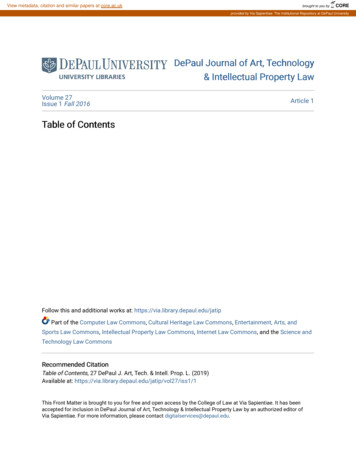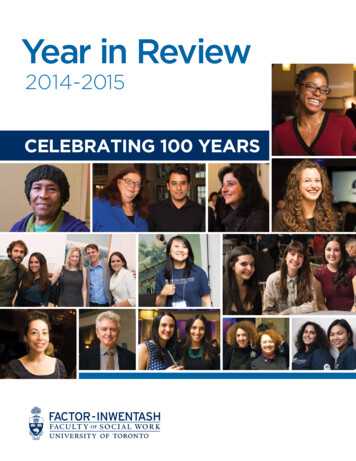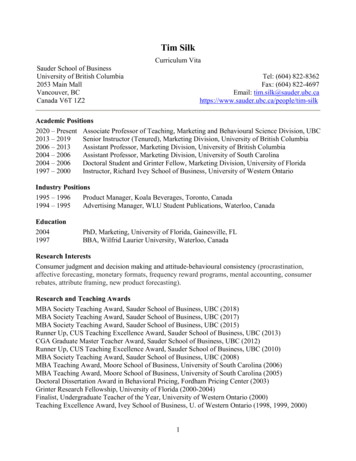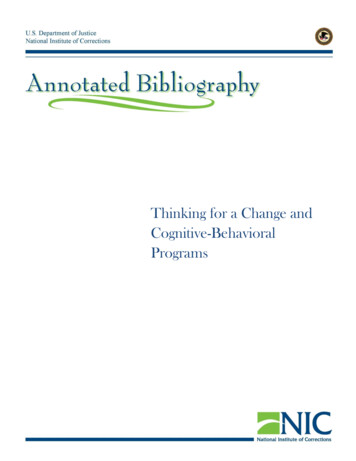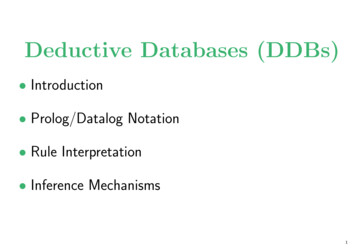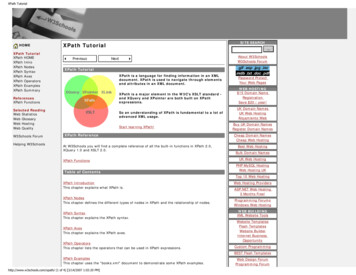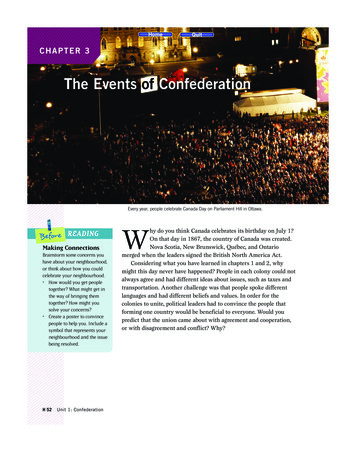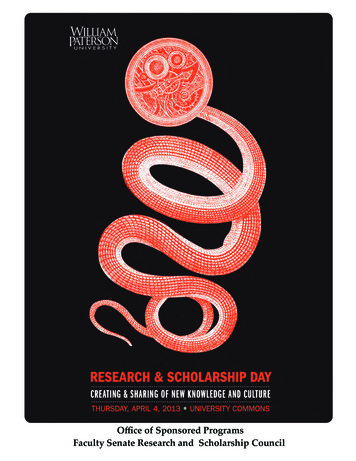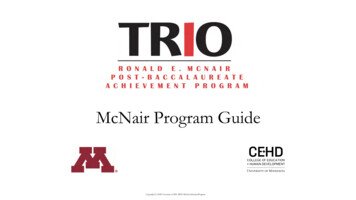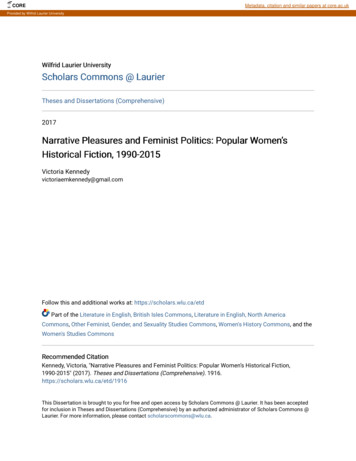
Transcription
COREMetadata, citation and similar papers at core.ac.ukProvided by Wilfrid Laurier UniversityWilfrid Laurier UniversityScholars Commons @ LaurierTheses and Dissertations (Comprehensive)2017Narrative Pleasures and Feminist Politics: Popular Women’sHistorical Fiction, 1990-2015Victoria Kennedyvictoriaemkennedy@gmail.comFollow this and additional works at: https://scholars.wlu.ca/etdPart of the Literature in English, British Isles Commons, Literature in English, North AmericaCommons, Other Feminist, Gender, and Sexuality Studies Commons, Women's History Commons, and theWomen's Studies CommonsRecommended CitationKennedy, Victoria, "Narrative Pleasures and Feminist Politics: Popular Women’s Historical Fiction,1990-2015" (2017). Theses and Dissertations (Comprehensive). 1916.https://scholars.wlu.ca/etd/1916This Dissertation is brought to you for free and open access by Scholars Commons @ Laurier. It has been acceptedfor inclusion in Theses and Dissertations (Comprehensive) by an authorized administrator of Scholars Commons @Laurier. For more information, please contact scholarscommons@wlu.ca.
NARRATIVE PLEASURES AND FEMINIST POLITICS:POPULAR WOMEN’S HISTORICAL FICTION, 1990-2015byVictoria E. M. KennedyB.A. English (Hons.), Wilfrid Laurier University, 2011M.A. English, York University, 2012DISSERTATIONSubmitted to the Department of English and Film Studiesin partial fulfillment of the requirements forDoctor of PhilosophyWilfrid Laurier University Victoria E. M. Kennedy, 2017
iAbstractThis dissertation contributes to a developing body of work on women’s historicalfiction and its significance to feminist discourse. Building from Diana Wallace’s 2005study The Woman’s Historical Novel: British Women Writers, 1900-2000, I offer amodified definition of “the woman’s historical novel” and a transatlantic consideration ofseveral of the most popular titles in the contemporary period, including The Other BoleynGirl (2001), Outlander (1991), A Great and Terrible Beauty (2003), and Scarlett (1991).Several studies have followed Wallace’s, notably Ann Heilmann and Mark Llewellyn’sMetafiction and Metahistory in Contemporary Women’s Writing (2007) and KatherineCooper and Emma Short’s The Female Figure in Contemporary Historical Fiction(2012). However, these studies are often somewhat highbrow in their scholarship; theyexamine prize-winning texts by authors like Angela Carter, A. S. Byatt, Michèle Roberts,Margaret Atwood, and Sarah Waters, but often leave the relationship between popularculture and feminist politics in bestselling women’s historical novels undertheorized. Onthe other hand, while feminist critics like Imelda Whelehan, Susan Douglas, and AndiZeisler have raised questions about the commercialization and dilution of feminist theorywhen it appears in popular fiction, film, television, and music, their studies have notaddressed historical fiction in detail. Since historical fiction is one of the most prominentgenres of the twenty-first century, this dissertation brings together the discourses offeminist pop culture criticism and theories of feminist historiography to address thetensions between narrative pleasures and feminist politics in some of the mostrecognizable women’s historical novels of the past twenty-five years. I offer a reading ofthese novels that illuminates how contemporary writers and readers uphold the
iiimportance of feminist gains when they imagine the past, but also express longing foraspects of traditional femininity that have been made taboo by modern feministdiscourse. My study considers the contradictions or tensions between the novels’ feministthemes, such as the importance of female autonomy, women’s education, and sisterhood,and the various pleasures these texts provide, such as romance, erotic content, reverencefor traditional gender roles, emphasis on clothes and other material trappings offemininity, and a focus on affluent, white, heterosexual women. Interrogating the variousfeminist and anti-feminist discourses and ideologies present in these popular, middlebrownovels, I attempt to add complexity and nuance to existing understandings of women’shistorical fiction as feminist historiography, and to consider how and why feministdiscourse is shaped by nostalgia, romanticization, and exoticism in these texts.
iiiAcknowledgments“We never know which lives we influence, or when, or why”— Stephen King, 11/22/63This research was made possible through an Ontario Graduate Scholarship and a DoctoralFellowship from the Social Sciences and Humanities Research Council of Canada.Sections from an early version of Chapter 1 were published as “Feminist Historical Revisioning or ‘Good Mills and Boon’?: Gender, Genre, and Philippa Gregory’s The OtherBoleyn Girl” in Pivot: A Journal of Interdisciplinary Studies and Thought 5.1 (2016): 4274.Sections from an early version of Chapter 2 were published as “The Way We Were:Nostalgia, Romance, and Anti-Feminism in Diana Gabaldon’s Outlander Series” inOutlander’s Sassenachs: Essays on Gender, Race, Orientation and the Other in theNovels and Television Series. Ed. Valerie Estelle Frankel. Jefferson, NC: McFarland,2016. 160-169.I am grateful to the anonymous peer-reviewers and the editors of those publications foroffering close readings and editorial suggestions that, in turn, strengthened the work ofmy chapters.My sincere thanks to Andrea Austin, Eleanor Ty, and Katherine Bell, whose carefulreading, guidance, and encouragement were instrumental to the completion of thisdissertation.I would like to thank my parents for their love and support, and for making sure I wassurrounded by books from an early age.I also send my heartfelt thanks to Steven Hill: sounding board, cheerleader, shoulder tocry on, maker of caffeinated beverages. this work and I owe you a great deal ofgratitude.And to all the many others whose influence led to or shaped this work, thank you.
ivTable of ContentsAbstract . iAcknowledgements . iiiTable of Contents . ivList of Figures . viiIntroduction:HISTORY, FEMINISM, AND POPULAR FICTIONHistoriography and the Historical Novel . 1Redefining the “Woman’s Historical Novel” . 6Feminism(s) and Feminist Literary Criticism . 14Feminism and Popular Culture: Working Toward a “Politics of Pleasure” . 17Case Studies . 22Chapter 1:BACK TO FORMULA:GENDER, GENRE, AND PHILIPPA GREGORY’S TUDOR NOVELSHistory vs. Historical Fiction . 28Historical Fiction and Romance . 34Blending “History from Below” with Historical Romance . 39The Other Boleyn Girl (2001) . 42The Boleyn Inheritance (2006) . 51The Queen’s Fool (2003) . 59The Virgin’s Lover (2004) . 67Selling and Selling Out . 72Chapter 2:THE PERSONAL IS POPULAR:NOSTALGIA AND THE POLITICS OF FEMALE BODIESIN DIANA GABALDON’S OUTLANDER SERIES“Sing Me a Song of a Lass That is Gone”: History and Women’s Bodies . 77
vGender and Genealogy in the Outlander Series . 83The Feminist Body in Outlander, Dragonfly in Amber, and Voyager . 87Nostalgia and Anti-Feminism in Outlander, Dragonfly in Amber, and Voyager . 94Reading the Outlander Series: Politics, Pleasures, and Disappearances . 118Chapter 3:HISTORY AND THE THIRD WAVE:YA READERS AND THE NEGOTIATION OF FEMINISM AND FEMININITYIN THE GEMMA DOYLE TRILOGYRemoving the Corset: Feminism and Fetishization . 123New Historical Modes: Neo-Victorian and Young Adult (YA) . 127Rebel/Angel: Gemma Doyle and the Tension Between Feminism and the Feminine . 135Victorian Undergarments and Third-Wave Sexual Politics . 142In Search of Our Mothers’ Gardens: Young Women and Matrilineal History . 148Sisterhood Under Siege: The Limits of Solidarity . 154Enlightened Sexism or Empowered Contradiction? . 161Chapter 4:FEMINIST HISTORICAL FICTION AND RACE:THE GONE WITH THE WIND LEGACY SINCE SCARLETTWhite Women and Southern History: Discursive Colonization . 164Scarlett (1991): Re-invigorating the Winds of Tradition . 172Strained Sisterhood: Scarlett’s Black Sister in The Wind Done Gone (2001) . 180Tenuous Allies in Cane River (2001) . 186Allies and Narrative Authority in The Book of Negroes (2007) . 190Scarlett Reborn in The Kitchen House (2010) . 196White Saviour Women in The House Girl (2013) . 203
viRuth’s Journey (2014) or Lack Thereof . 207Dual Perspectives: Abolition and First-wave Feminism in The Invention of Wings(2014) . 212The Winds of Change . 218Conclusion:NEW DIRECTIONSAND A RECONCEPTUALIZATION OF MOVEMENT . 223References . 229
viiList of FiguresFigure 1: Cover images of the Gemma Doyle trilogy . 127Figure 2: YA neo-Victorian novels featuring corsets on the covers . 161Figure 3: Corseted and bustled women on the covers of the Luxe novels . 162
1— Introduction —History, Feminism, and Popular Fiction“I can read poetry and plays, and things of that sort, and do not dislike travels.But history, real solemn history, I cannot be interested in.It tells me nothing that does not either vex or weary me.The quarrels of popes and kings, with wars or pestilences, in every page;the men all so good for nothing, and hardly any women at all — ”— Jane Austen, Northanger Abbey1Historiography and the Historical NovelMy epigraph from Austen’s Northanger Abbey (1818) presents a moment whenthe heroine, Catherine Morland, despairs that there is nothing pleasurable in reading “realsolemn history.” Nothing, certainly, to rival the psychological and physical sensationsthat are incited when she reads fiction. The opposition of these two forms, history andfiction, is based on the supposition that history is fact while fiction is fantasy. Althoughthere are still historical theorists and literary critics who uphold this division, in the twohundred years since Catherine Morland despaired the solemnity of history, the linebetween history and fiction has become increasingly blurred. Indeed, historical fiction inthe contemporary period, which I date as the period of the past fifty years from the mid1960s to the present, might best be considered a form that brings some of the pleasures offiction reading together with the factuality and educational value of history.The blurring of history and fiction occurred as historiography—theories of thewriting of history—began to acknowledge the similarities between the way fictional and1Austen, Jane. Northanger Abbey. Ed. Marilyn Gaull. New York: Pearson Longman, 2005. 88.Diana Wallace’s The Woman’s Historical Novel also begins with a consideration of this quote fromNorthanger Abbey.
2historical narratives are constructed and consumed. Prior to the mid-twentieth century,the dominant view was that there was such a thing as objective history or historical truth(which I frequently refer to throughout this dissertation as “Capital-H History”), and thatit was the historian’s duty to uncover and convey this objective truth. In his midnineteenth-century text Lectures of the Philosophy of History, G. W. F. Hegel lays outwhat he sees as the primary goals and foundational methods of writing history. ForHegel, history progresses toward an ultimate end that has been pre-ordained by God. Thehistorian’s role, in Hegel’s view, is to attempt to understand the overall shape andmovement of history, and, as he puts it: “to consider world history in relation to itsultimate end” (46). Hegel is wary of historians who practice what he calls “reflectivehistory,” for they often commit three sins: bringing their own spirits into the historicalnarrative, bringing the present into the past, and fragmenting one aspect of history (helists “the history of art, of law, or of religion”) from the wider historical context (23). Yetwhile Hegel and many of his ancestors, contemporaries, and descendents advocated forobjective, holistic historiography, historians in the mid- to late-twentieth century morereadily recognized that there is no such thing as objective history. Rather, the historianmediates history through language and thus inevitably shapes it, leaving a metaphoricalfingerprint on the historical narrative.In the mid-twentieth century, postmodern discourse led to a shift in historiographyaway from deterministic and teleological models, like Hegel’s, toward a more nuanced,self-reflexive mode. In his 1960 book, What is History?, the well-established anddecorated historian E. H. Carr challenges the idea of the historian as a conveyor of fact,instead stressing that the historian has a subjective and idiosyncratic relationship to his
3data. Speaking of nineteenth-century historiography, Carr argues that it was too reverenttoward the idea of truth, envisioning the historian as the passive receiver or collector offacts that existed “independent of his consciousness” (9). Carr debunks the fetishizationof fact, asserting strongly and early in his text that “the facts speak only when thehistorian calls on them: it is he who decides to which facts to give the floor, and in whatorder or context” (11). Consequently, Carr urges historians to exercise self-reflexivity intheir work, recognizing the role that individual subjectivity plays in the communicationof history. This idea is also described by Hayden White in a series of writings includingthe iconic 1972 essay “The Historical Text as Literary Artifact.” Here and elsewhere,White argues that the work the historian does in creating a history out of historical eventsis comparable to the work the novelist does in creating a narrative out of plot elements.White calls the process of the historian arranging historical data “emplotment” (223)—emphasizing the way this activity relies on the same techniques authors employ whenmaking fictional narratives. The significance of recognizing the emplotment of history,White explains, is that it forces one to acknowledge that “most historical sequences canbe emplotted in a number of different ways, so as to provide different interpretations ofthose events and to endow them with different meanings” (224). In short, objectivity andtruth were no longer held sacred in historiography of the late twentieth century. Rather, asMichel Foucault wrote in 1971, truth is simply an “error that cannot be refuted because itwas hardened into an unalterable form in the long baking process of history” (79).These postmodern challenges to master narratives that purport to be truth—including capital-H History—created opportunities for historians and historical noveliststo undermine established history by writing what E. P. Thompson, in 1966, called
4“history from below.” History from below calls attention to the ways that gender, race,and class have impacted the construction of established historical narratives. As LindaHutcheon noted in 1989, “we now get the histories (in the plural) of the losers as well asthe winners, of the regional (and colonial) as well as the centrist, of the unsung many aswell as the much sung few, and I might add, of women as well as men” (66). If thehistorian controls the elisions, emphases, and biases of a historical narrative, then itfollows that there are alternate histories that have never been popularized because theycould not or would not be written by those with the education and platform to write andpublish history. Indeed, it is within this context that much contemporary women’shistorical fiction operates as a challenge to the erasure and marginalisation of women inthe established narratives of history. While it would be false to say that pre-1960historical fiction was uniformly un-self-reflexive, it seems safe to say that, in the latetwentieth century, it became extremely difficult for historians and historical novelists totake “truth” or “fact” for granted.The academic study of historical fiction as a literary genre stems primarily fromGyörgy Lukács’ The Historical Novel, published in Russian in 1937 but not published inEnglish until 1962. In his study, Lukács identifies Sir Walter Scott’s Waverley (1814) asthe first historical novel. The subtitle of Waverley, ‘Tis Sixty Years Since, establishes theoft-upheld rule for defining whether a novel may be considered historical. Put simply, inorder to be considered a historical novel, the plot must be set at least sixty years in thepast, just as Waverley, the genre’s urtext, was set. In positioning Waverley as the firsthistorical novel, Lukács discounts earlier novels that he says contain “historical themes”rather than being “historical novels.” He writes:
5“The so-called historical novels of the seventeenth century (Scudéry, Calpranède,etc.) are historical only as regards their purely external choice of theme andcostume. Not only the psychology of the characters, but the manners depicted areentirely those of the writer’s own day.” (19)In contrast, Scott is identified as the father of the historical novel because in his novels,“the historical characterization of time and place, the historical ‘here and now’ issomething much deeper [than picturesque descriptions]” (41). Thus, in defining thehistorical novel for literary theory and criticism, Lukács adopts an objectivist viewsimilar to that of historiographers like Hegel. Just as Hegel argues that the historian mustnot influence historical fact, Lukács argues that the historical novelist must not allow hispresent sensibilities to influence his representation of history. Finally, it must be notedthat Lukács’ examination of the historical novel since Waverley is entirely focused onmale authors. He identifies Hugo, Balzac, Tolstoy, and Flaubert as Scott’s most notabledescendants.The publication of an English translation of The Historical Novel in 1962coincided with the postmodern shift in historiography and the rise of the postmodernhistorical novel. Thus, as critics in the late twentieth and early twenty-first centuries haveresponded to and elaborated Lukács’ study in increasing numbers, the parameters usedfor defining and studying historical fiction have shifted. Historical objectivism—thenotion that the author can keep his or her modern sensibilities and knowledge frominfluencing his or her representation of the past— is no longer a required feature of ahistorical novel. In fact, novels like The House on the Strand (du Maurier; 1969),Kindred (Butler; 1979), and Possession (Byatt; 1990) exemplify the popular trend of
6blurring the line between past and present, challenging the separation of the two.Furthermore, critics in the contemporary period have struggled to redefine how far in thepast a novel must be set in order to be considered “historical.” Many continue to upholdthe “sixty years since” rule derived from Waverley, but others have offered alternativeways of measuring historicity. Diana Wallace, for instance, presents a more flexibledefinition, asserting that a novel may be considered “historical” if it is set in a periodbefore the birth of the author (x). Thus, the period can vary depending on the age of theauthor. However, even here I suggest there must be room for exceptions, as in the case ofolder authors. For instance, few would question the categorization of Margaret Atwood’sThe Blind Assassin (2001) as historical fiction, even though Atwood, born in 1939, wasalive in the 1930s and 40s when the novel is set. Thus Lukács’ study, thoughfoundational to genre criticism, is no longer considered the standard by which historicalnarratives are measured. Instead, contemporary critics have broadened their view of thegenre and are examining it through new critical lenses including, notably, postcolonialand feminist frameworks.Redefining the “Woman’s Historical Novel”Returning to Catherine Morland and her complaints about history in NorthangerAbbey, it is clear that the exclusion of women from “real solemn history” is one ofAusten’s heroine’s primary complaints. Addressing the exclusion of women fromCapital-H History is one of the most visible ways that contemporary historical novelistswrite “history from below.” In On Lies, Secrets, and Silence (1978), Adrienne Richdescribes a process she calls “re-visioning,” a process that is defined as “looking back, of
7seeing with fresh eyes, of entering an old text from a new critical direction” (35). Manyfemale authors of contemporary historical novels engage in exactly this process, reentering history through the critical lens of feminist discourse. However, the idea of abody of work unified as “the woman’s historical novel” is relatively new; the term comesfrom Diana Wallace’s 2005 study The Woman’s Historical Novel, which was the firstfull-length scholarly study to apply a feminist lens to the study of historical fiction. Infact, Wallace re-writes the history of the historical novel, arguing that Walter Scott’sWaverley (1814) was not the first historical novel in English, asserting instead that it wasSophia Lee’s The Recess (1783). Wallace defines the woman’s historical novel, quitesimply, as a historical novel that is “written and read by women” (x). Her study buildsfrom the argument that “the historical novel has been one of the most important forms ofwomen’s reading and writing during the twentieth century (ix).” What her study revealsis that gender can account for different approaches to genre. Where György Lukácsviewed realism and an emphasis on the common man—and he did mean man—as thedefining traits of the genre, Wallace persuasively demonstrates that women havefrequently written historical fiction in romantic modes, arguing that “the ‘popular’historical novel has given women more freedoms than the realist version” (22). Heroverview of twentieth-century British women’s historical fiction foregrounds the waysthat historical fiction has enabled a female-focused view of history. Though women hadbeen writing historical novels since the eighteenth century, Wallace suggests that they“turned to the historical novel at the beginning of the [twentieth] century, at a momentwhen male writers were moving away from the genre” (3).
8Part of the reason women turned to historical fiction in increasing numbers wasthat, starting in the early decades of the twentieth century, women were permitted aneducation beyond any to which they had been admitted previously. History becameformally accessible to women scholars, as it had never been before. Moreover, asWallace notes, it was during these early decades of the century that most Western womenbegan “entering into history as enfranchised citizens” (25) following the suffragemovements. Indeed, the rise of women’s historical fiction in the twentieth century occursin tandem with the development of second- and, later, third-wave feminist discourse. Theargument made by Wallace, and taken up in this dissertation, is that the development offeminist discourse is not isolated to academic or political writing but appears also inwomen’s historical novels. Wallace’s study shines a spotlight on the feminist andhistorical implications of historical novels by British women writers like GeorgetteHeyer, Naomi Mitchison, Daphne du Maurier, Mary Stewart, Catherine Cookson, and A.S. Byatt. She does, however, note that her work excavating and analyzing women’shistorical novels is simply “a beginning” that offers “reassessments of what a ‘historicalnovel’ and/or a ‘woman’s novel’ might be” (xi). My study is enormously indebted toWallace’s work, but it also builds upon her work in two important ways: (i) by offering arevised definition of “the woman’s historical novel,” and (ii) by offering a newmethodological framework that more fully considers the role that popularity plays in theproliferation of women’s historical novels and complicates the relationship betweenpopular genre narrative and feminist discourse.The way I define the woman’s historical novel, which I also refer to throughoutthis dissertation as the female-focused historical novel, is not based primarily on the sex
9of the author or the presumed reader, but rather on the focalization and themes of thenarrative. In my study, the woman’s historical is redefined to mean a historical novel thatis focalized through a female character’s perspective and focuses on the micro-details ofher life—her embodied, personal experiences—against the macro backdrop of history. Inthis way, a female-focused historical novel tells the marginalized and erased stories ofwomen in historical times when men tend to be the dominant figures of capital-HHistory. On the other hand, popular male-focused historical novels such as BernardCornwell’s The Archer’s Tale (2000)2 and Jeffrey Archer’s Only Time Will Tell (2011)focalize their texts through male characters. In doing so, they do not challenge capital-HHistory in quite the same way as the woman’s historical novel. They do not engage in thefeminist work of excavating and reclaiming women’s histories—the work that is anessential component of the woman’s historical novel. However, in my study, thewoman’s historical novel is a narrative mode rather than a biological label that describesthe text’s writer or reader. I redeploy Wallace’s term “the woman’s historical novel”using the possessive “woman” to refer to the woman character(s) at the centre of ahistorical novel rather than the writer or readers, though I acknowledge that they tend tobe women. According to my revised definition, Hilary Mantel’s Wolf Hall (2009) doesnot utilize this narrative mode, but Lawrence Hill’s The Book of Negroes (2007) does. Asthe commercial success of the woman’s historical novel has been proven by popular textslike those I examine in this study, the past two decades have seen several male-authoredworks that operate in the same female-focused mode, for example: Memoirs of a Geisha(Golden; 1997), Atonement (McEwan; 2001), and Brooklyn (Tóibín; 2009). In ChapterFour, I discuss two examples of male-authored woman’s historical novels, Hill’s The2Published in the UK as Harlequin
10Book of Negroes and Donald McCaig’s Ruth’s Journey (2014). By expanding thedefinition of the woman’s historical novel to include female-focused narratives that arewritten by male authors, my study attempts to avoid some of the essentializing thatsometimes occurs in feminist literary criticism. Furthermore, my study more thoroughlyconsiders the fact that female writers are not necessarily feminist writers.In terms of my methodological departure from Wallace, she argues that the twoends of the spectrum, “the ‘popular’ and the ‘serious’ or ‘literary’” are “intimatelylinked” (5), and her analysis flows almost seamlessly through a century of women’shistorical novels of vastly differing publishing contexts and receptions. While I agreewith Wallace that the popular is by no means divorced from the political, I argue thatmore attention must be paid to the different mechanics and receptions of highbrow orliterary historical fiction and popular historical fiction. My study aims to trouble theconnection between feminist historiography and popular fiction by analysing several ofthe points of tension between the two. This dissertation, being a study of popular cultureas much as of literature and feminism, uses some unorthodox sources. Examining literarycriticism, feminist theory, historians’ accounts, and historical novels alongside articlesand reviews from popular culture sources like Buzzfeed, USA Today, The Telegraph andPublishers Weekly, I am able to explore the way popular novels often exist in the worlds
Outlander (1991), A Great and Terrible Beauty (2003), and . Scarlett (1991). Several studies have followed Wallace's, notably Ann Heilmann and Mark Llewellyn's Metafiction and Metahistory in Contemporary Women's Writing (2007) and Katherine Cooper and Emma Short's . The Female Figure in Contemporary Historical Fiction (2012).
